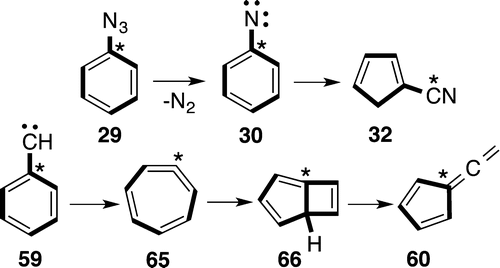当前位置:
X-MOL 学术
›
J. Am. Chem. Soc.
›
论文详情
Our official English website, www.x-mol.net, welcomes your
feedback! (Note: you will need to create a separate account there.)
Phenylnitrene, Phenylcarbene, and Pyridylcarbenes. Rearrangements to Cyanocyclopentadiene and Fulvenallene
Journal of the American Chemical Society ( IF 14.4 ) Pub Date : 2014-10-17 , DOI: 10.1021/ja506151p David Kvaskoff 1 , Holger Lüerssen 1 , Pawel Bednarek 1 , Curt Wentrup 1
Journal of the American Chemical Society ( IF 14.4 ) Pub Date : 2014-10-17 , DOI: 10.1021/ja506151p David Kvaskoff 1 , Holger Lüerssen 1 , Pawel Bednarek 1 , Curt Wentrup 1
Affiliation

|
Flash vacuum thermolysis (FVT) of phenyl azide 29 as well as precursors of 2-pyridylcarbene 34 and 4-pyridylcarbene 25 affords phenylnitrene 30 (labeled or unlabeled), as revealed by matrix isolation electron spin resonance spectroscopy. FVT of 1-(13)C-phenyl azide 29 affords 1-cyanocyclopentadiene (cpCN) 32, which is exclusively labeled on the CN carbon, thus demonstrating direct ring contraction in phenylnitrene 30 without the intervention of cycloperambulation and 1,3-H shifts. However, the cpCN obtained by rearrangement of pyridyl-2-((13)C-carbene) 34 carries (13)C label on all carbon atoms, including the CN carbon. Calculations at the B3LYP/6-31G* level and in part at the CASSCF/6-31G* and CASPT2/cc-pVDZ//CASSCF(8,8)/cc-pVDZ levels support a new mechanism whereby 2-pyridylcarbene rearranges in part via 1-azacyclohepta-1,2,4,6-tetraene 36 to phenylnitrene, which then undergoes direct ring contraction to cpCN. Another portion of 2-pyridylcarbene undergoes ring expansion to 4-azacyclohepta-1,2,4,6-tetraene 42, which then by trans-annular cyclization affords 6-azabicyclo[3.2.0]cyclohepta-1,3,5-triene 43. Further rearrangement of 43 via the spiroazirine 44 and biradical/vinylnitrene 45 affords cpCN with the label on the CN group. An analogous mechanisms accounts for the labeling pattern in fulvenallene 60 formed by ring contraction of 1-(13)C-phenylcarbene 59 in the FVT of 1-(13)C-phenyldiazomethane 58.
中文翻译:

苯基氮烯、苯基卡宾和吡啶基卡宾。重排为氰基环戊二烯和富烯丙烯
如基质隔离电子自旋共振光谱所示,苯基叠氮化物 29 以及 2-吡啶基卡宾 34 和 4-吡啶基卡宾 25 的前体的快速真空热解 (FVT) 提供了苯基硝基 30(标记或未标记)。1-(13)C-苯基叠氮化物 29 的 FVT 得到 1-氰基环戊二烯 (cpCN) 32,它专门标记在 CN 碳上,因此证明了苯基硝基 30 中的直接环收缩,而没有环行和 1,3-H 位移的干预. 然而,通过吡啶基-2-((13)C-卡宾) 34 重排获得的cpCN 在所有碳原子上都带有(13)C 标记,包括CN 碳。B3LYP/6-31G* 水平和部分 CASSCF/6-31G* 和 CASPT2/cc-pVDZ//CASSCF(8,8)/cc-pVDZ 水平的计算支持一种新机制,即 2-吡啶卡宾在部分通过 1-azacyclohepta-1,2,4, 6-四烯 36 生成苯基硝基苯,然后直接缩环生成 cpCN。2-吡啶基卡宾的另一部分进行扩环成 4-氮杂环庚-1,2,4,6-四烯 42,然后通过跨环环化得到 6-氮杂双环 [3.2.0] 环庚-1,3,5-三烯43. 43 通过螺氮丙啶 44 和双自由基/乙烯基硝基 45 的进一步重排得到带有 CN 基团标签的 cpCN。1-(13)C-苯基重氮甲烷 58 的 FVT 中 1-(13)C-苯基卡宾 59 的环收缩形成了富烯烯 60 中的标记模式。43 通过螺氮丙啶 44 和双自由基/乙烯基硝基 45 的进一步重排得到带有 CN 基团标签的 cpCN。1-(13)C-苯基重氮甲烷 58 的 FVT 中 1-(13)C-苯基卡宾 59 的环收缩形成了富烯烯 60 中的标记模式。43 通过螺氮丙啶 44 和双自由基/乙烯基硝基 45 的进一步重排得到带有 CN 基团标签的 cpCN。1-(13)C-苯基重氮甲烷 58 的 FVT 中 1-(13)C-苯基卡宾 59 的环收缩形成了富烯烯 60 中的标记模式。
更新日期:2014-10-17
中文翻译:

苯基氮烯、苯基卡宾和吡啶基卡宾。重排为氰基环戊二烯和富烯丙烯
如基质隔离电子自旋共振光谱所示,苯基叠氮化物 29 以及 2-吡啶基卡宾 34 和 4-吡啶基卡宾 25 的前体的快速真空热解 (FVT) 提供了苯基硝基 30(标记或未标记)。1-(13)C-苯基叠氮化物 29 的 FVT 得到 1-氰基环戊二烯 (cpCN) 32,它专门标记在 CN 碳上,因此证明了苯基硝基 30 中的直接环收缩,而没有环行和 1,3-H 位移的干预. 然而,通过吡啶基-2-((13)C-卡宾) 34 重排获得的cpCN 在所有碳原子上都带有(13)C 标记,包括CN 碳。B3LYP/6-31G* 水平和部分 CASSCF/6-31G* 和 CASPT2/cc-pVDZ//CASSCF(8,8)/cc-pVDZ 水平的计算支持一种新机制,即 2-吡啶卡宾在部分通过 1-azacyclohepta-1,2,4, 6-四烯 36 生成苯基硝基苯,然后直接缩环生成 cpCN。2-吡啶基卡宾的另一部分进行扩环成 4-氮杂环庚-1,2,4,6-四烯 42,然后通过跨环环化得到 6-氮杂双环 [3.2.0] 环庚-1,3,5-三烯43. 43 通过螺氮丙啶 44 和双自由基/乙烯基硝基 45 的进一步重排得到带有 CN 基团标签的 cpCN。1-(13)C-苯基重氮甲烷 58 的 FVT 中 1-(13)C-苯基卡宾 59 的环收缩形成了富烯烯 60 中的标记模式。43 通过螺氮丙啶 44 和双自由基/乙烯基硝基 45 的进一步重排得到带有 CN 基团标签的 cpCN。1-(13)C-苯基重氮甲烷 58 的 FVT 中 1-(13)C-苯基卡宾 59 的环收缩形成了富烯烯 60 中的标记模式。43 通过螺氮丙啶 44 和双自由基/乙烯基硝基 45 的进一步重排得到带有 CN 基团标签的 cpCN。1-(13)C-苯基重氮甲烷 58 的 FVT 中 1-(13)C-苯基卡宾 59 的环收缩形成了富烯烯 60 中的标记模式。


















































 京公网安备 11010802027423号
京公网安备 11010802027423号